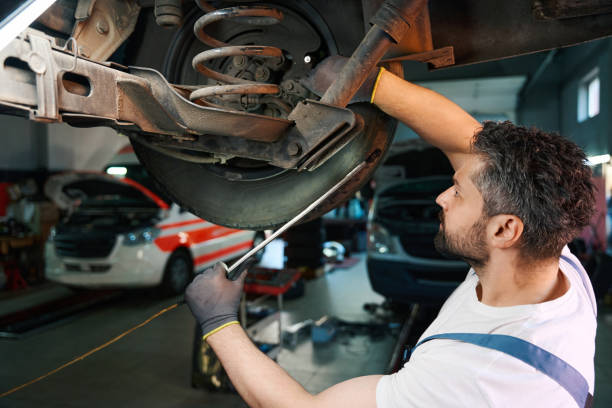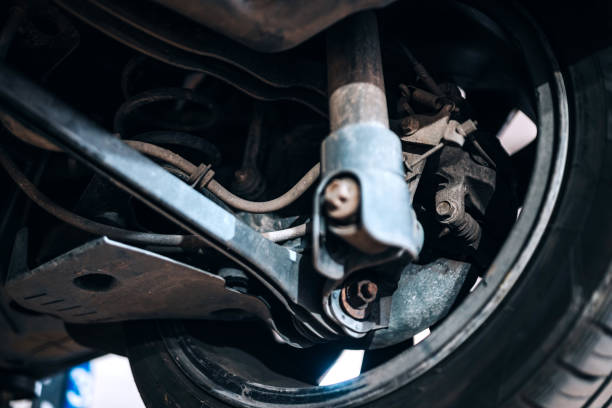December 21, 2023
What are the two main components of a suspension system?
The two main components of a suspension system in a vehicle are:
- Springs: Springs are designed to absorb and store energy when the vehicle encounters bumps, potholes, or uneven road surfaces. They provide a cushioning effect and help maintain contact between the tires and the road. There are various types of springs used in suspension systems, including coil springs, leaf springs, and torsion bars.
- Dampers (Shock Absorbers): Dampers, commonly referred to as shock absorbers, are designed to control the oscillations of the springs and reduce the bouncing and vibrations of the vehicle. They work by dissipating the kinetic energy generated when the springs compress and rebound. Shock absorbers help maintain stability, improve ride comfort, and ensure that the tires stay in contact with the road surface.
These two components work together to provide a balanced and comfortable ride while ensuring the vehicle’s tires maintain good traction and handling characteristics, especially when driving over uneven terrain or rough roads.
What is the most common suspension systems?
The most common suspension system found in modern passenger vehicles is the “independent suspension” system. Independent suspension allows each wheel to move vertically and independently of the others, providing a smoother and more comfortable ride while also improving traction and handling. There are several types of independent suspension systems:
- MacPherson Strut Suspension: This is one of the most common types of independent front suspension systems used in many front-wheel-drive vehicles. It consists of a single suspension component called the MacPherson strut, which combines the shock absorber and coil spring into a single unit. This design is relatively simple and cost-effective.
- Double Wishbone (A-Arm) Suspension: Double wishbone suspension uses two A-shaped control arms per wheel, which are connected to the wheel hub and the vehicle’s frame or subframe. This design allows for precise control over wheel movement and is often used in performance and luxury vehicles due to its handling benefits.
- Multi-Link Suspension: Multi-link suspension is a more complex design that uses multiple control arms and links to provide excellent handling and ride comfort. It is often used in higher-end vehicles where a balance of performance and comfort is desired.
While independent suspension is the most common in passenger vehicles, there are also other suspension systems like solid rear axles, which are often found in trucks and some rear-wheel-drive cars. Solid rear axles are simpler and more rugged but tend to provide a less comfortable ride and may not handle as well as independent suspension systems.
It’s worth noting that suspension design can vary widely depending on the vehicle’s type, purpose, and manufacturer, so you may find variations and combinations of these systems in different vehicles.
What are the three most commonly used suspension systems?
The three most commonly used suspension systems in vehicles are:
- Independent Suspension: Independent suspension allows each wheel to move vertically and independently of the others, providing a smoother ride, better handling, and improved traction. It is the most common suspension system in modern passenger cars and is often found in both the front and rear axles. Types of independent suspension systems include MacPherson strut, double wishbone (A-arm), and multi-link suspension.
- Solid Rear Axle (Beam Axle): A solid rear axle, also known as a beam axle, is a simpler suspension system where both rear wheels are connected to a single solid axle. This design is often used in trucks and some rear-wheel-drive cars, as it is more robust and suitable for heavy-duty applications. However, it may sacrifice some ride comfort and handling compared to independent suspension.
- Torsion Beam Suspension: Torsion beam suspension is a variation of independent suspension primarily used in compact and subcompact cars. It consists of a single beam connecting the rear wheels, with the beam acting as a torsion bar to provide suspension and damping. This design is cost-effective and space-efficient but may not offer the same level of handling performance as more complex independent suspension systems.
These three suspension systems cover a wide range of vehicle types and applications, from passenger cars to trucks and SUVs. The choice of suspension system depends on factors like the vehicle’s intended use, design, and performance requirements.


